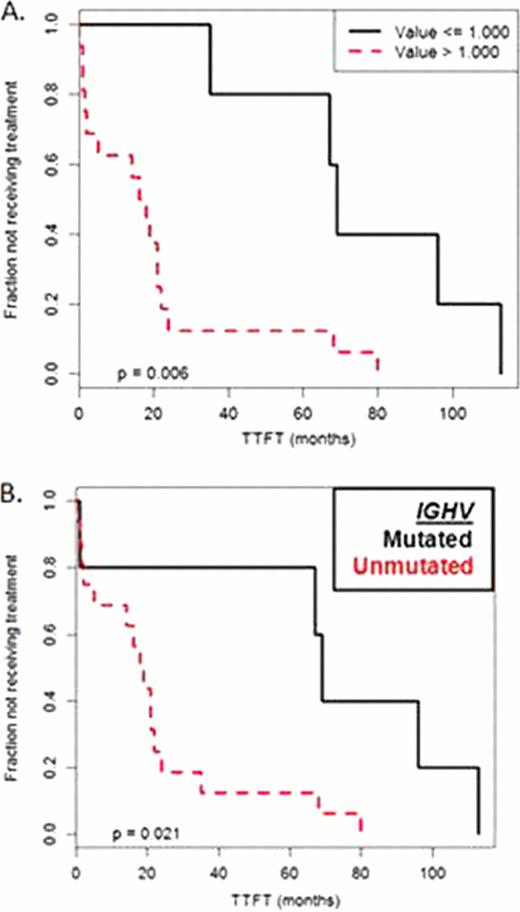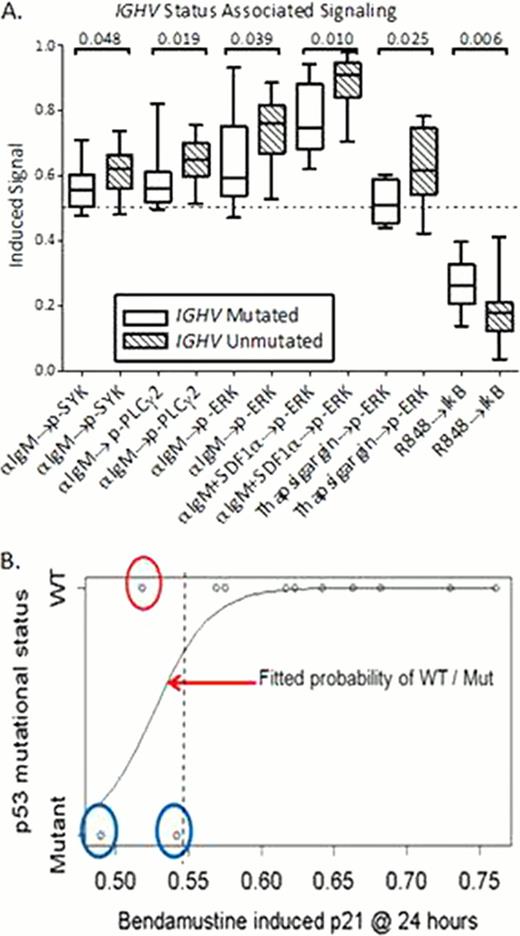Abstract
Abstract 1783
CLL follows a highly variable clinical course. Evidence suggests that BCR signaling is a driving event in disease onset and progression. SCNP is a multiparametric flow cytometry-based assay that measures changes in intracellular signaling proteins in response to modulators, providing a functional measure of pathway activity. In prior studies using samples collected from patients with Binet Stage A CLL but at different time points in the natural history of their disease, an association between elevated BCR signaling and shorter TTFT was observed (Cesano et al. ASH 2011 Abstract 2834). In order to assess the correlation of CLL biology (measured by SCNP) and clinical course in a clinically more homogeneous population, samples collected as part of a clinical trial from elderly patients with previously untreated CLL prior to therapy initiation were assessed.
1) To confirm the association between αIgM-induced (→) p-ERK signaling and TTFT in an independent CLL patient cohort, and 2) to identify additional associations between signaling and prognostic, molecularly defined clinical subgroups (i.e. IGHV and p53 mutational status).
29 evaluable cryopreserved CLL peripheral blood patient samples were collected between November 2008 and January 2010 as part of a Phase II trial. These studies were not part of the trial. Of the 29 samples, 20 were IGHV unmutated and 12 had unfavorable cytogenetics (del11q22.3 and/or del17p13) with 2 carrying p53 mutations. SCNP analysis was performed to quantitatively measure 18 intracellular signaling proteins within CD19+CD5+ CLL cells using a panel of 14 disease-relevant modulators. Cox Proportional Hazards regression was performed and Kaplan–Meier curves were used to assess signaling associations with TTFT in the 24 Binet A/B samples, as the prior TTFT association with BCR signaling was identified in Binet A samples. Wilcoxon signed-rank test and logistic regression were used to identify signaling associations with p53 and IGHV mutational status.
Consistent with prior studies, αIgM→p-ERK signaling was associated with TTFT (p=0.05, likelihood ratio (LR) test). Notably, the combination of SDF1α and αIgM modulation induced greater p-ERK signaling than observed with either agent alone and displayed a stronger association with TTFT (p=0.02) (Figure 1A). For this cohort, only the IGHV mutational status (p=0.01) (Figure 1B) and not cytogenetic risk categories, CD38, or ZAP-70 showed a significant association with TTFT. In addition, combining IGHV with αIgM→p-ERK did not improve predictive power. Significant associations to IGHV unmutated status (Figure 2A) included multiple nodes modulated by αIgM (p-ERK, p-PLCγ2, p-SYK). The strength of this relationship was greater using concurrent stimulation with αIgM+SDF1α. R848 (TLR7/8 agonist) and thapsigargin (Ca2+ influx) signaling were also increased in the unmutated samples.
Finally, since the induction of p21 is in part regulated by p53 we tested the hypothesis that the lack of p21 induction by the DNA damaging agent, bendamustine, will be associated with p53 mutations. Samples with high spontaneous apoptosis in the absence of drug were removed prior to unblinding. Of the 13 evaluable samples, there was a significant association to p53 mutational status and p21 induction by bendamustine (p=0.0125, LR test, Figure 2B).
These data confirm the association of BCR and BCR+SDF1α signaling with disease progression in CLL, and the potential for SCNP to identify patients more likely to require early treatment. These data support the potential utility of SCNP to: (1) identify in one assay those patients with a more aggressive form of CLL, including both unmutated IGHV and p53 pathway alterations, and (2) identify patients with signaling profiles who may be more likely to respond to targeted therapies.
Kaplain-Meier curves comparing TTFT for: (A) Patients stratified based on the log2Fold αIgM+SDF1a→p-ERK in CLL cells and (B) Patients divided based on the IGHV mutational status. p-values are for the log rank test.
Kaplain-Meier curves comparing TTFT for: (A) Patients stratified based on the log2Fold αIgM+SDF1a→p-ERK in CLL cells and (B) Patients divided based on the IGHV mutational status. p-values are for the log rank test.
(A) B-CLL cells from patients with unmutated IGHV had greater induced signaling. Dashed line represents unmodulated signal. (B) Prior to unblinding clinical data, it was pre-specified that samples having reduced bendamustine-induced p21 expression levels would carry p53 mutations.
(A) B-CLL cells from patients with unmutated IGHV had greater induced signaling. Dashed line represents unmodulated signal. (B) Prior to unblinding clinical data, it was pre-specified that samples having reduced bendamustine-induced p21 expression levels would carry p53 mutations.
Ptacek:Nodality, Inc.: Employment, Equity Ownership. Evensen:Nodality, Inc.: Employment, Equity Ownership. Hawtin:Nodality, Inc.: Employment, Equity Ownership. Friedland:Nodality, Inc.: Employment, Equity Ownership. Ware:Nodality, Inc.: Employment, Equity Ownership. Cordeiro:Nodality, Inc.: Employment, Equity Ownership. Cesano:Nodality, Inc: Employment, Equity Ownership.
Author notes
Asterisk with author names denotes non-ASH members.



This feature is available to Subscribers Only
Sign In or Create an Account Close Modal